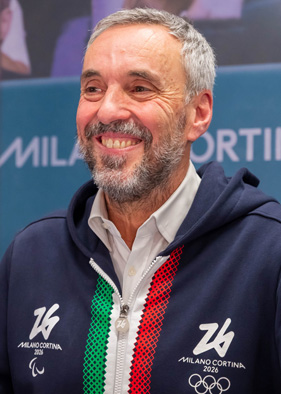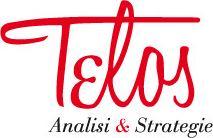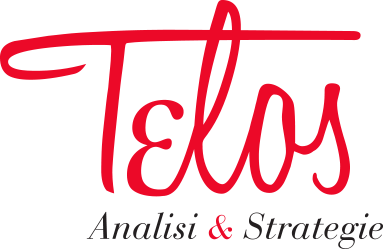July 2025, Year XVII, no. 7
Andrea Varnier
Olympic Magic
“For me and for my entire generation, the Olympics have been the greatest sporting event there is. They are that magic which is sparked every four years, or better, every two, between the summer and winter Games.”
Telos: CEO of the Fondazione Milano Cortina 2026. Tell us about your story, your jobs, and the spirit inspiring your work?
Andrea Varnier: For me and for my entire generation, the Olympics have been the greatest sporting event there is. They are that magic which is sparked every four years, or better, every two, between the summer and winter Games. My first memory of the Olympics goes back to Monaco 1972, the first Olympics broadcast in colour.
I went to watch them at an uncle’s house in Belgium. I can still remember watching the swimming events and Mark Spitz winning with a big moustache and no swimming cap, as well as the medals of Novella Calligaris. As for how I got to Milano Cortina 2026, I was selected by the Meloni government at the end of the autumn 2022 on the recommendation of the Minister of Sport Andrea Abodi, who always follows the whole run-up to the upcoming Winter Olympic and Paralympic Games very closely. We needed to reconnect with our potential sponsors and worked a lot on that, and the announcements of the recent months are proof. This event is a challenge for Italy as a whole. We want the 2026 Milano Cortina Games to relaunch the values of sport, attract millions of young people to disciplines other than football, our national sport, and remind us that Italy is capable of great things and we have no reason to be envious.
Our mission, in line with the 2020+5 Olympic Agenda, is to create an innovative, sustainable model for the Games, inspired by the vibrant, contemporary energy of the Italian spirit, which through sport is offering numerous job opportunities for the new generations, shaping the managers of tomorrow. A spirit that will shine through the excellence of the athletes, the flames of the Torch, the snow on our mountains, the lights of our cities. Ours is a country of creativity, beauty and ingenuity, where strength and passion combine to evolve and grow. We are ready to welcome the whole world into our amazing country so that everyone can discover all our wonders, with spectators who, in addition to witnessing the greatest feats in sports and being mesmerised by our mountains, will also be able to admire our beauty and art cities.
The Games are coming up soon. Where are you at in terms of the preparations?
We are satisfied with the progress we have made in the last months. Two years ago, there was considerable concern regarding the creation of the infrastructure. When I got here, almost no work had been started on the worksites. Today, we can say that we are quite satisfied with the current state of the works. We know all the works will be completed shortly before the beginning of the Games, so our job, along with Simico, the government agency in charge of the infrastructure, is to constantly monitor their progress. As part of our broader program of preparatory initiatives, the test events carried out last winter using the official infrastructure offered us at Fondazione Milano Cortina 2026 a valuable opportunity to recreate the race conditions and fine tune procedures in view of the quickly approaching Games.
Moreover, we have been working daily on a series of activities that are less visible but fundamental, encompassing every aspect of the experience of both the athletes, the true nerve centre of our project, and the fans who will be coming from all over the world. We have a lot of organisational and logistical challenges, but this is one of the driving forces of the success of Milano Cortina 2026. Much will be inherited from these Olympics. In Milan, for example, the Olympic village will remain, conceived and constructed as a dormitory for future university students. Cortina already hosted the Olympics in 1956, and it is really special to come back seventy years later and see its skiing infrastructure gleaming once again. For example, the Curling Olympic Stadium, the venue for the 1956 opening ceremony, will not only be hosting the events, it will also provide a stunning backdrop for the closing ceremony of the Paralympic Games on 15 March 2026. Another unique spot is the Verona Arena. We are working on making one of the most iconic historical landmarks in the world more accessible, not only for the closing Olympic ceremony and the opening Paralympic ceremony but also in order to leave something behind for future generations. From a glorious past to a shining future: we want to share the passion of the Games with more than just the areas where the Olympic and the Paralympic Games are taking place, we want to share it with the whole country.
What will make these Games special, unforgettable?
The 2026 Milano Cortina Games will show the world the best Italy has to offer. To carry out this common project, our territories have joined forces, leveraging skills they already have. The beauty of our places is known throughout the world: not only of Milan and Cortina, but also of Bormio, Tesero, Predazzo, Anterselva, as well as of Verona and Livigno.
To ensure the best scenario possible for the athletes, the true protagonists of the Games, we are relying on the know-how and experience these territories have already accumulated in the organisation of international sporting events. For example, we know that the opening ceremony is a very special moment for each athlete and that, because of the event schedule, not all of them will be able to be present at San Siro Stadium on 6 February 2026.
However, the athletes are the true protagonists of the Games, so we are organising something special in the places where the Olympic events will be held to involve them and make this moment unique and unforgettable: a scattered opening ceremony for scattered Games.
Your being named CEO of the Foundation is no accident and undoubtedly the result of your impressive professional career. Could you tell us about a past experience that helped you resolve or avoid a present problem?
Each Olympics I have worked on since Turin 2006 has allowed me to see and learn something different. The experiences of the past are certainly useful, just as it was useful for me to attend the recent Paris 2024 Olympics as an observer with many of my colleagues from the Fondazione Milano Cortina 2026 to get inspiration for our Games. But every experience is different from the last and needs to be put into context. For instance, we learned from each challenge and each difficulty we had to overcome at Turin 2006 and Rio 2016, so it is hard to compare different editions in different periods during years when many things, from for example communication to technology, have radically evolved. So it would not any make sense to compare them because each edition of the Olympics is unique and special.
Marco Sonsini
Editorial
Wearing an Olympic medal is a privilege reserved for the few, yet anybody who loves sport conserves at least one Olympic medallist in their memory. And when it comes to the winter Olympics, one face stands out in the collective imagination: Alberto Tomba and his Olympic debut in Calgary in 1988, with a gold won in the giant slalom and then in the special slalom, all broadcast live on RAI public television instead of the highly popular San Remo Festival of Italian music. A watershed, not only for the world of sport. Even our July guest for PRIMOPIANOSCALAc, Andrea Varnier, CEO of the Fondazione Milano Cortina 2026, tells us about his first memory, dating back to the Munich Olympics in 1972: “I can still remember watching the swimming events and Mark Spitz winning with a big moustache and no swimming cap, as well as the medals of Novella Calligaris.” Since then, Varnier has worn many hats in the organisation of the Olympics, starting with the 2006 Turin Olympics. In the autumn of 2022, Varnier was summoned almost at the last minute to make up for lost time in the organisation of the upcoming winter Olympics, which are now right around the corner, with the inauguration slated for 6 February 2026.
Varnier reminds us how the Olympic spirit is rekindled by the flame uniting sport, culture and territories. The Olympic torch, carried by the torchbearers, is still a symbol of an age-old ritual handed down through the centuries, proof of the union between peoples and the power of the universal language of sport. One curious fact: the “Essential” Olympic torches of these Games have been engineered and manufactured right here in Italy, in Lombardy, to be exact. The journey of the torch will officially begin on 26 November 2025 from Olympia and it will travel 12,000 kilometres, traversing 60 cities in 63 days. And Varnier’s job is truly massive. Check out these numbers, which don’t even broach the topic/problem of infrastructure: 87,000 hotel rooms, 60,000 WI-FI connections, 35,000 uniforms, 1,000 drones, 2,000 anti-doping tests, 1,000 metal detectors, 880,000 meals to serve.
Yet the challenges are many: finding sponsors, this year in February 400 of the 500 million euros in sponsorships had already been pre-arranged, and getting the infrastructure ready, something that is not the responsibility of the Foundation, although it monitors the situation and breathes down the neck of the companies. The 2026 Winter Games will be held in both Milan and Cortina d’Ampezzo, with events distributed over four main areas.
The decision was made to decentralise the Games (a ‘scattered’ model), connecting cities and mountain towns, in order to take advantage of the already existing infrastructure and limit new construction. However, it also entails new organisational challenges, especially when it comes to transportation and coordinating staff. Relying on sites traditionally used for winter sports ensures that there will be quality facilities with skilled personnel. However, it will require a well-oiled logistical machine to cover the distances between the various sites. One of the most emblematic projects regards the Verona Arena chosen as the venue for the closing ceremony of the Olympics Games and the opening ceremony of the Paralympic Games, which entails making an almost 2000-year-old Roman amphitheatre wheelchair accessible. This sends a strong message that even historical landmarks can become inclusive.
The press greeted Varnier’s appointment with expressions like “low-profile manager” and by saying that his was not “a big-sounding name,” but everyone acknowledged his impressive totally respectable résumé. After two years, all we can say is that Varnier has managed to jump-start a machine that was stuck, to say the least. Choosing an excellent professional in this sector not only made sense, it was the right move.
Red, black and white, these are the traditional colors of Telos A&S that you will find in the 2025 cover graphics of PRIMOPIANOSCALAc. We reveal our guest’s identity by showing half of their face on one side and a quote from the interview on the other. Their name is written in Abril Fatface, a classy font inspired by 19th-century European advertising posters.
Mariella Palazzolo

Andrea Varnier has been the CEO of the Fondazione Milano Cortina 2026 since 1 December 2022. After spending the first part of his career in the corporate sector, from the automotive sector to telecommunications, he entered the world of large sporting events. In 2001 he was appointed Director of Image and Events for the Turin 2006 Winter Olympics and Paralympics. He later became a consultant for the International Olympic Committee for the 2008 Beijing Olympics. For the 2016 Rio Games, Varnier was the CEO of one of the organisers, the Cerimonias Cariocas.
Here he worked on the creation of the Olympic and Paralympic opening and closing ceremonies, the journey of the Olympic and Paralympic torch and the welcome ceremonies for the teams and management services for the Live Sites. In 2017 he became the CEO of Filmmaster Events and Filmmaster Productions, a world leader in the creation of large events, in audiovisual communication and in the production of advertising commercials. In 2020 Varnier became the Global CEO of the strategic international communications consulting firm Richard Attias & Associates based in Dubai where he oversaw and organised the Ryad G20. In July 2022 he was made CEO of Costa Edutainment, a company that is a pioneer in the management of public and private sites and large facilities dedicated to recreational, cultural, education activities and scientific research.
Andrea Varnier has a degree from the DAMS (Arts, Music and Performing Arts) programme at the University of Bologna and was born and bred in Verona, but is a globetrotter by vocation. He loves swimming and skiing and practised athletics in his youth. Now he is interested in a little of all sports.
Marco Sonsini







SocialTelos